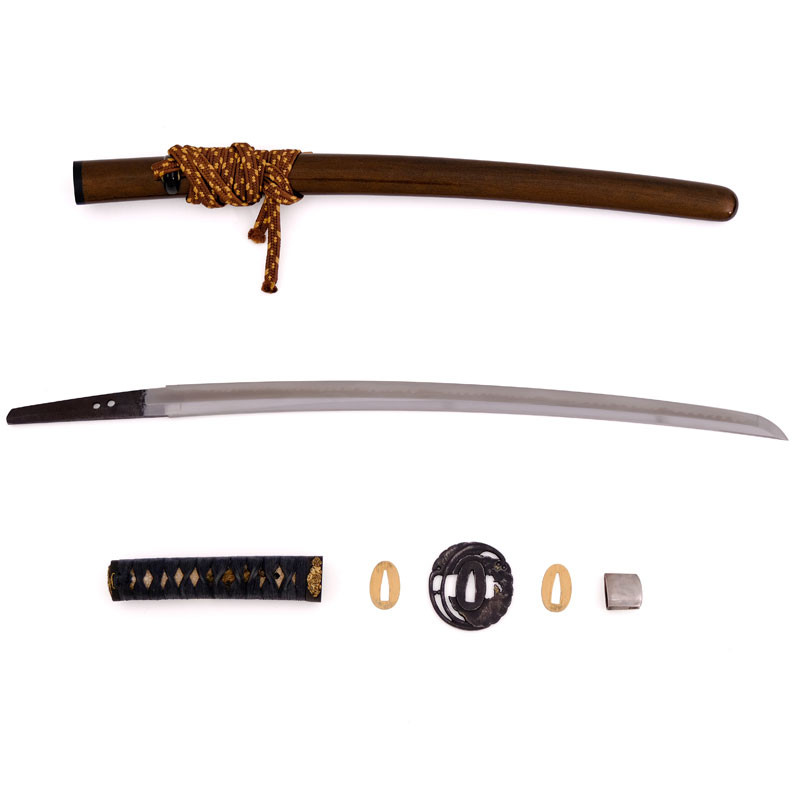



















More informations about this product
| Total Weight | 0.941 kg | |
| Weight without Saya | 0.723 kg | |
| Blade Weight | 0.471 kg | |
| Full Blade length (Toshin) | 65.60 cm | |
| Nagasa | 52.10 cm | |
| Nakago Length | 13.50 cm | |
| Sori (curvature) | 1.50 cm | |
| Kissaki Length | 2.80 cm | |
| Moto Haba | 2.91 cm | |
| Saki Haba | 1.88 cm | |
| Moto Kasane | >A = 0.56 cm B = 0.70 cm |
|
| Saki Kasane | A = 0.41 cm B = 0.48 cm |
|
| Curvature | Tori Zori with light Funbari | |
| Type Kissaki | Chū Kissaki (Medium) | |
| Blade Structure | Shinogi Zukuri (diamond shaped) | |
| Mune | Iori Mune (triangular) | |
| Hamon | Wide Gunome Choji with a Yakidashi-type start, presence of Nijuba, Ashi, Yo and fine Sunagashi. | |
| Hada | Ko Itame / very fine Masame | |
| Boshi | Ko-Maru Kaeri with wide quenching | |
| Nakago | Ubu, signed on Omote ‘藤原實行’ Fujiwara Saneyuki, Length 13.5 cm, 2 mekugi Ana, Classic Futsu Gata shape, Yasurime Katte Sagari on the sides (very slightly inclined), Yasurime Sujikai on Mune and Ha (Inclined), Kuri Jiri tip in Iriyama Gata Jiri (V Asymmetric). | |
| Saya | Weight: 214g, Length 56.4 cm, glossy lacquer Golden brown, Sageo bicolored polyester Brown and golden, Koiguchi and Kurigata in horn with gilded Shitodome, Rounded Saya tip, space for Kogatana. | |
| Tsuka & Tosogu (Tsuba, Menuki, Fuchi Kashira) |
- Tsuka: Weight 107 g, Length 17.2 cm, Same White whole, Black silk Tsumami Maki braiding, Menuki in Sentaku, Dragon Pattern, Fuchi Kashira with golden Shishi (Komainu) patterns on a black patinated Nanako background. - Tsuba : Weight 101 g, Dimensions 7.02x7.41x0.47cm, Kawari Gata Shape (hugging the pattern), Leaf Pattern in Sukashi and Nikubori technique with traces of golden stripes, Typical Kinai school. - Habaki: Weight 30g, Copper covered with silver leaf, Unpatterned on sides (Muji), Nekogaki sur Mune and Ha. Seppa: 2 Seppa golden copper, fine rounded crenellation, total weight 10g. |
|
| Study & Team Review |
This blade is signed "Fujiwara Saneyuki" 藤原實行, blacksmith of the Takada school located in the ancient province of Bungo, Kyushu. The Sugata (shape and dimensions) is typical of early Edo period blades, from Kanei to Kanbun, between 1640 and 1670. |
|
Share your opinion
error Your review appreciation cannot be sent
feedback Report comment
check_circle Report sent
error Your report cannot be sent